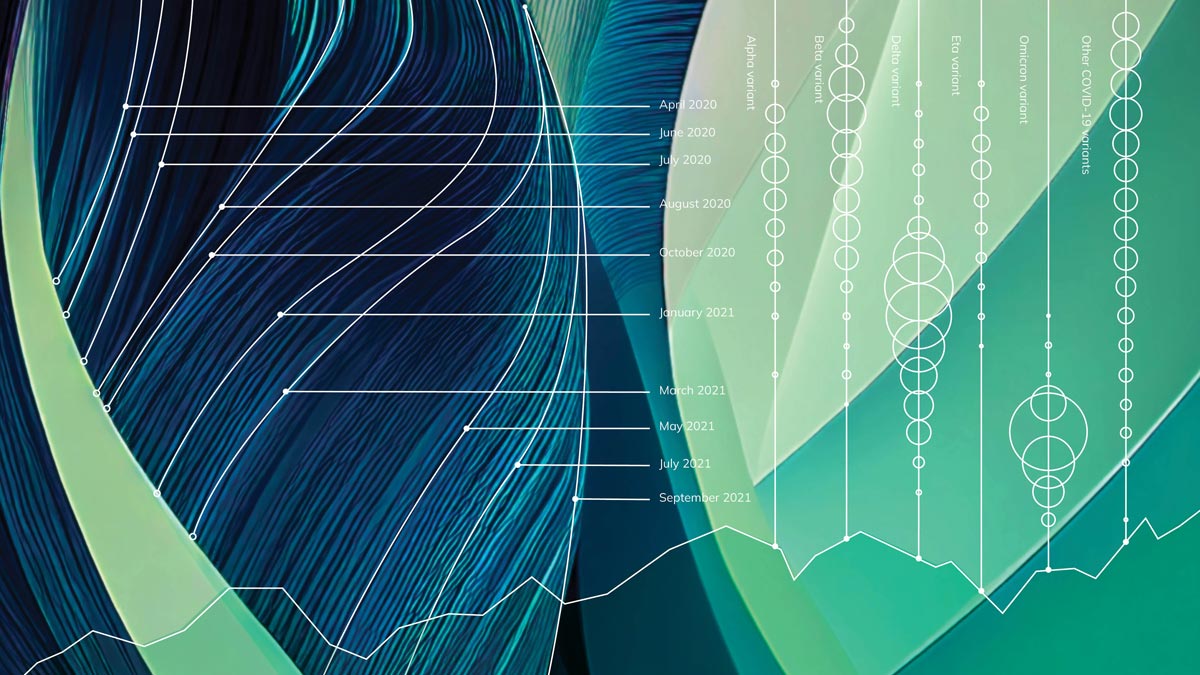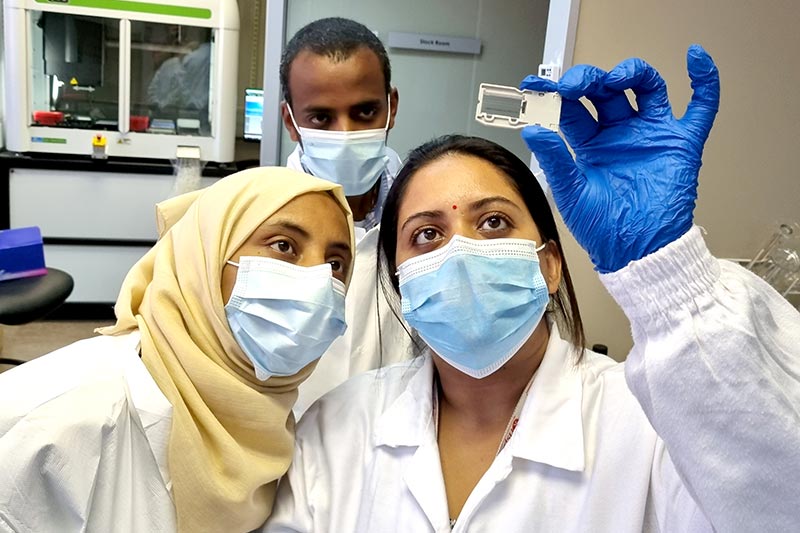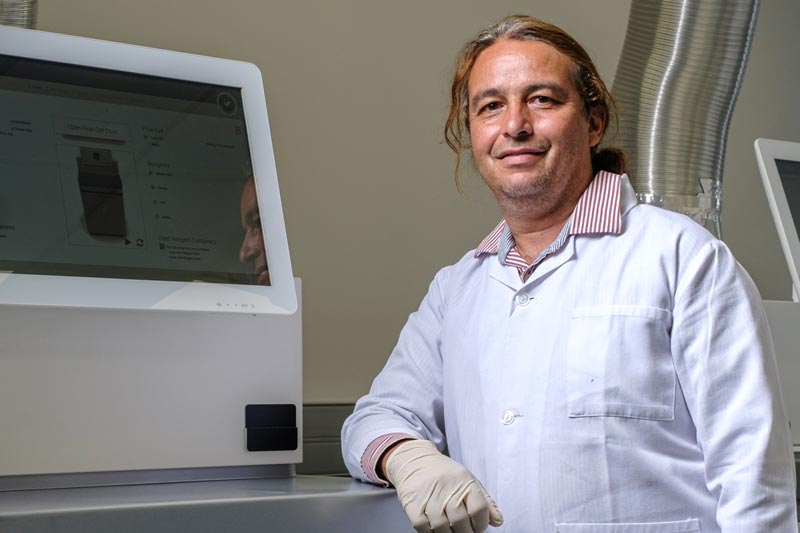Crossing boundaries to build bridges – CERI leads the fight against epidemics
Michèle Meyer

Illustration by Ronel van Heerden
At the Centre for Epidemic Response and Innovation (CERI), a team of dedicated scientists is crossing transdisciplinary boundaries in its search for information regarding global health threats, and in its interpretation of this data.
Leading this team is Prof Tulio de Oliveira, director of CERI and the KwaZulu-Natal Research Innovation and Sequencing Platform (KRISP).
De Oliveira and his team earned worldwide recognition for detecting the Beta variant of SARS-CoV-2 in late 2020. In November 2021, a few months after De Oliveira joined the Stellenbosch University (SU) ranks as a professor in the School for Data Science and Computational Thinking, he and his co-workers also detected the Omicron variant.
Today, the CERI team is successfully using big data across a range of disciplines to address current epidemics and to prepare for possible future global health threats.
Big data for gigantic challenges
‘Big data’ is one of the recent buzzwords being used in the war against global health threats such as the COVID-19 pandemic. This term refers to extremely large datasets that lend themselves to computational analysis. The latter reveals patterns, trends and associations, especially ones relating to human behaviour and interaction.
Given that we live in a time of information overload, big datasets can assist scientists in applying specific deductions or associations reached through computational analytics in the devising of smart solutions for a plethora of issues.
At CERI, big data is analysed to reveal links between seemingly unrelated factors in the interdisciplinary fight against epidemics.
De Oliveira explains: “We link all kinds of previously unrelated data. In the analysis of epidemics, we link data related to climate, temperature, humidity and rain levels with mobility data – which is collected every time someone uses a mobile phone – and with flight and epidemiological data. The latter entails the number of cases of infection and the genomes that we produce.”
Linked epidemiological data such as this can reveal the environment’s role in the spread of diseases, how diseases move, and how they are introduced around the world. It is through this linking of data that the researchers at CERI came to understand aspects of the spread of COVID-19. The waves of infection during winter were associated with people spending more time indoors due to cold weather. The waves that followed in summer were associated with higher mobility – pleasant weather led to people spending more time socialising and travelling.
Similarly, linked data from CERI’s work in Brazil and Africa has revealed that outbreaks of certain diseases transmitted by mosquitoes are more likely when the conditions for mosquitoes are ideal. Such conditions are normally associated with wet months and higher temperatures. “Here, the lesson is not only about how diseases are spread but, more importantly, about how to develop systems and tools to control or prevent them,” De Oliveira says.

Dr Jennifer Giandhari inspects an Illumina MiSeq flow cell with Ethiopian fellows Rajiha Abubeker and Dawit Hailu during their genomics fellowship at KRISP in 2022. Photo by Paul Harris

Prof Tulio de Oliveira | Photo by Stefan Els
A truly transdisciplinary centre
CERI is based in the School for Data Science and Computational Thinking at SU but spans across another two SU structures, the Faculty of Medicine and Health Sciences and the Faculty of Science. According to De Oliveira, CERI is the first body to interlink different SU faculties and infrastructures in this way.
“Our work is transdisciplinary in nature. We have medical staff who see the patients. They are involved in clinical management and identification, sampling and ensuring proper medical care for patients. These staff members are part of the medical and biomedical team; they work on what we refer to as the ‘bad side’, close to the threat of infection through their interaction with patients. In the process, they learn and document as much as possible, while giving continuous assistance.
“In this manner, we build sample collections that can then move to our genomics laboratories where DNA data is produced. Our big laboratories are based in the Faculty of Medicine and Health Sciences on our Tygerberg campus. In addition to the data analysts at Tygerberg, we also link with the Faculty of Science. We strive to interlink various areas: biology, bioinformatics and ecology. It is essential to understand the environmental factors that drive epidemics.”
CERI also cross-links with contributors from more technical disciplines such as computer science and engineering. Electronic engineers are responsible for coding some of the softer applications needed for CERI’s work, and for developing new mathematical formulae and applying them in the research process. This makes CERI a truly transdisciplinary centre.
Breaking boundaries to return to a universal view
Traditionally, academic institutions and universities are horizontally organised, with individual faculties representing clearly defined disciplines. CERI takes an alternative stand that challenges the concept of isolated disciplines within the University.
“What CERI does is groundbreaking, but we are not the first to do this at SU. The School for Data Science and Computational Thinking and the School for Climate Studies do groundbreaking work in their attempts to cut across different disciplines. These schools are partaking in a big movement currently occurring in the world’s top scientific research laboratories and universities. Once we start breaking down the barriers between disciplines, moving the focus away from earning credit for a specific discipline towards answering the obvious scientific question, we rapidly boost the level of science.”
In less than a year after its establishment, researchers linked to CERI have been published multiple times in some of the world’s top scientific journals. The Centre’s results have driven much of the global response to epidemics. Clearly, once the barricades between disciplines are removed, cooperation can lead to the answering of questions with a public interest.
“The best way to prove this is by producing high-level science that will convince other academics and university structures that transdisciplinary cooperation has its merits,” De Oliveira says.
This is, however, easier said than done.
“People get quite nervous when they sense that disciplines are being ‘invaded’. Some departments and faculties retain a sense of ownership over their field of research. You should be able to use ecological data even if you don’t work in the biology department, or generate genomic data even if you’re not part of the DNA facility.
“The idea is not new. The word ‘university’ is derived from ‘a universal view’. To move back to the original intent, toward a universal reaction to challenges, will be beneficial,” De Oliveira argues.
The past, present and future of epidemic research
Looking into the recent past at how the world responded to the coronavirus holds clues to how tracking new variants of the virus can prepare us for the next global health threat.
“It’s not surprising that we were one of the global leaders in scientific response to the coronavirus because, during the last five or ten years, we became involved in responding to all the previous epidemics – HIV, TB, Zika, dengue, chikungunya, yellow fever, West Nile virus, Rift Valley fever. When the coronavirus hit, our team, involving both CERI and KRISP, was already used to responding to epidemics. As such, we could rapidly pivot our attention to the new epidemic.”
Today, De Oliveira believes, it is more important to return our attention to the current epidemics faced by South Africa and Africa at large than to prepare for possible future epidemics. Much of the progress made in HIV and TB research in the last five years was lost during the pandemic. It is essential, he argues, that scientific resources and facilities be used for renewed research on these two diseases. In particular, their genomes must be generated and linked to big data in order to improve tailor-made therapy.
Three current focus areas of the HIV and TB work done at CERI are understanding the transmission of these illnesses, identifying the correct interventions to decrease it, and explaining treatment drug resistance.
Apart from HIV and TB, De Oliveira also identifies malaria, Ebola and hepatitis B, C and E as diseases in dire need of research attention in the African context. The latter hepatitis strain is fast becoming problematic, specifically in refugee camps.
Global south leads the fight
“CERI responds to current epidemics, pivots back quite strongly, but also prepares for future epidemics,” De Oliveira emphasises.
“Towards the end of 2022, we will be launching a large global programme, Climate-Amplified Diseases and Epidemics (CLIMADE). [...] The idea is to create a global consortium, led by the global south, that will identify areas that are most likely to suffer from epidemics associated with climate change and global warming. The World Health Organization; Africa Centres for Disease Control and Prevention; a strong partner in Brazil, the Oswaldo Cruz Foundation (Fiocruz); and partners from the global north will also be involved. Countries from the global south should lead the programme because this is where these epidemics cause mass suffering. Through means of the consortium, the data can be collected and information disseminated swiftly, helping the entire globe to develop therapies and vaccines.
“We expect 60% of existing pathogens to become more dangerous with global warming. There is much talk about pathogens associated with vectors such as mosquitoes and ticks, as well as climate (cold winters and hot summers), but also about waterborne pathogens that are associated with floods. Dozens of countries around the world are suffering unheard-of outbreaks of cholera,” says De Oliveira.
To him, this is not surprising. With the global environment having been under severe strain over the past few centuries and with humankind’s continuous nonchalant attitude towards the culminating devastation, outbreaks of epidemics are inevitable, he says. Sociopolitical and economic problems compound the effect.
Adding to our dilemma, De Oliveira says, is the global increase in antimicrobial resistance – a disease-causing microbe’s development, through mutation or gene transfer, of the ability to survive exposure to an antimicrobial agent that was previously an effective treatment for the relevant disease. “Genomics plays a crucial role in antimicrobial resistance. If we are careless, the world can lose most of the antibiotics available to us within the next few decades. Overuse of antibiotics is a very real issue.
“In developing countries, in addition to epidemics caused by pathogens, we will see an increase in epidemics associated with lifestyle and the fact that people now live longer. Cancer, diabetes and high blood pressure are all examples. My concern lies with the masses of poor individuals suffering from not only high levels of violence, unemployment and mental health but also physical diseases.”
Strength in unity
CERI follows a work ethic that emphasises teamwork. De Oliveira chuckles when asked about this methodology.
“Of course, teamwork is what produces high-level science. We have a truly transdisciplinary team that works in unison. Each sub-team consists of highly experienced individuals. Our clinical team understands diseases from a clinical perspective. We have a laboratory team that produces genomic data and diagnostics in real time. Our data analysis team is quite large, with around 20 individuals analysing data in real time. Each of them applies their specific expertise. Various engineers develop software applications. Someone with a strong biological background will do the evolutionary analysis, whereas someone with a mathematical background will do the mathematical analysis.”
None of this would be possible without financial support, De Oliveira points out.
“What people may not realise is that procurement and grant managers play a crucial role in providing scientific support. This important team must ensure that funds are raised, managed well and reported, both financially and operationally. 95% of our work is not funded by Stellenbosch University but by external grant donors. These grant applications are extremely competitive. Currently, we have 14 large grants, the majority being from international sources.”
Since April 2021, CERI and KRISP have hosted over a hundred fellows from 33 different African countries. The aim is to teach these individuals how to produce and analyse data. After receiving training, they return home with all the protocols and scripts needed for data analysis. This allows for the analyses to be replicated in the countries that the fellows hail from. Recently, this fellowship programme was extended to Latin America. De Oliveira says there are also plans to expand the programme to countries in the southern and southeastern parts of Asia. All of this forms part of an effort to support countries from the global south.
“This may sound counter-intuitive, as if we are giving away our secrets. We are, however, building a very strong network of researchers who can work together. It also builds trust. Our fellows are individuals, not numbers.”
Proof of this network is the paper recently published in Science, one of the top two scientific journals in the world. Over 300 collaborators from more than 150 institutions contributed to this paper on the genomic surveillance of the SARS-CoV-2 pandemic in Africa.
CERI has become a beacon of hope in a time of global health threats. Its role in relentlessly mapping out protocols and solutions for current and future epidemics is highly regarded. This international acclaim is evident from the fact that the Massachusetts Institute of Technology listed the centre’s work on identifying and tracking COVID-19 variants as one of the top ten technological breakthroughs of 2022. The centre aims to keep crossing boundaries in its mission to move humanity forward, collectively.
For more information, visit CERI’s website.